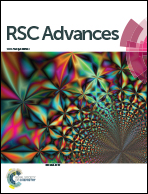Iron/acetic acid mediated synthesis of 6,7-dihydrodibenzo[b,j][1,7]phenanthroline derivatives via intramolecular reductive cyclization†
Abstract
An efficient iron/acetic acid mediated intramolecular reductive cyclization protocol for the synthesis of novel 6,7-dihydrodibenzo[b,j][1,7]phenanthroline derivatives is described. In this two-step procedure, aldol addition and reductive cyclization methods are effectively utilized for the construction of C–C and C–N bonds. This highly efficient process proceeds under mild conditions, tolerates different functional groups, and provides various substituted 6,7-dihydrodibenzo[b,j][1,7]phenanthroline derivatives in good to excellent yields. In addition, various synthetic utilities of these derivatives are also described.
![Graphical abstract: Iron/acetic acid mediated synthesis of 6,7-dihydrodibenzo[b,j][1,7]phenanthroline derivatives via intramolecular reductive cyclization](/en/Image/Get?imageInfo.ImageType=GA&imageInfo.ImageIdentifier.ManuscriptID=C5RA06395G&imageInfo.ImageIdentifier.Year=2015)

 Please wait while we load your content...
Please wait while we load your content...